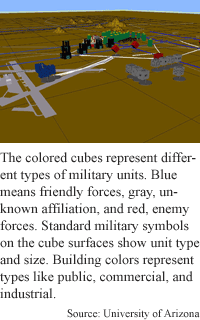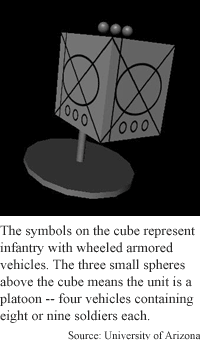
Decision
tool keeps it simple
By
Chhavi Sachdev,
Technology Research NewsThe old days of dotting miniature tanks and soldiers across a map in order to plan military strategy may be coming back in a virtual fashion. Researchers at the University of Arizona have devised software that packs strategic information into a three-dimensional model that can be run on an ordinary laptop.
The software uses symbols to represent real-life objects. Just as air traffic displays have a universally-accepted set of symbols, the semantics and syntax of which are clear to speakers of all languages, the software has a set of symbols for military movements, said Jerzy Rozenblit, a professor of computer engineering at the University of Arizona.
The set is based on standard military symbols. A square enclosing a circle with an X through it, for example, denotes a mechanized unit, or troops accompanied by armored vehicles. The software depicts the square as one side of a cube. The other sides display information such as remaining fuel, distance to destination, and strength of the force, said Rosenblum "A simple display of that kind does not clutter the display from a visual and perceptual point of view," he said.
These types of visualization concepts should help commanders make decisions in complex battlefield situations, and their use is not limited to traditional, conventional types of conflict, said Rozenblit.
The software could be used for plotting disaster relief, refugee relief operations, delivering food supplies, or setting up democratic governing systems in unstable political arenas, Rozenblit said. Any situation that requires a lot of strategic information to be packed into a small space and the various players to be moved around would benefit, he said.
The software is also widely applicable because it allows for sophisticated visualization without requiring a lot of computer power. "We really don't deal with high resolution, very detailed graphical representations. We work on an abstract level, so this can be run on a laptop machine," said Rozenblit.
The program has three levels, he said. The top layer displays a scenario. The middle layer consists of the graphics routines and engines that drive and animate the scene, Rozenblit said. The bottom layer is a simulation model that executes the behavior involved with the mission. "What's really involved here is an artificial intelligence component that lends decision support," he said.
The simulation tool includes genetic algorithms that sift through the thousands of available courses of action and narrow them down to, say, five of the best options, Rozenblit said. “It takes seconds to generate the options,” he said.
The options are displayed in a list for the commander, who can run them in turn to see the consequences of each choice, he said. “We are now building in the capability to run them automatically,” Rozenblit said.
Scenarios are created by the user and can be saved in a library and reloaded. The symbols can be customized, or built upon the graphical elements already in the library, said Rozenblit.
Since there is no coding involved, training is relatively intuitive. It could be used not only to see possible courses of action, but also to train commanders by checking to see if they make the right decisions, said Rozenblit.
The work is a nice use of artificial intelligence that could prove very useful, said Paul Juell, an associate professor of computer science at North Dakota State University. "Too many people try to produce beautiful pictures and forget the goal of presenting information."
The system's winning point is that the information is clear despite the use of spatial coordinates to present dense glyphs of information, said Juell. "It is hard to present enough details to aid the decision process but not to hide the underlying patterns."
These overall patterns are important for decision making, Juell said. "Simple global displays, such a trend line, hide the local details. The display produced by this project gives the best of both worlds," he said.
Because the system presents only good options and filters out the rest, "the viewer [can] address the problem rather than having to deal with hundreds of options," said Juell.
One limitation of the system, however, is that a suitable set of features will have to be found every time the system is used in a new domain, Juell added.
The researchers plan to test the visualization system within the next six months to gauge reaction times and error rates, and see how well decisions are actually made, said Rozenblit.
Currently, the software is like a chess game with two players on opposite sides. The researchers are planning to add the capacity for more than two points of view. They also have plans to connect the software directly to databases that will stream real-time information into the model, Rozenblit said. Multiple points of view should be possible within a year; real-time data support will take two to three years, he said.
The researchers are also looking at the effectiveness of the symbols, and developing a graphical means of expressing probabilities and uncertainties, such as the chances of a mission's success, said Rozenblit.
Rozenblit's research colleagues were Liana Sauntak and Faisal Momen at the University of Arizona, Michael Barnes at the U.S. Army Research Laboratories, and Ted Fichtl of The Compass Foundation. They presented the research at the 2001 IEEE International Conference on Systems, Man, and Cybernetics held in Tucson, Arizona from October 7 to 10, 2001. The research was funded by the U.S. Army Research Laboratories.
Timeline: now; 2-3 years
Funding: Government
TRN Categories: Data Representation and Simulation; Artificial Life and Evolutionary Computing
Story Type: News
Related Elements: Technical paper, "Intelligent Decision Support of Support and Stability Operations (SASO) through Symbolic Visualization" in proceedings of the 2001 IEEE International Conference on Systems, Man, and Cybernetics, Tucson, Arizona, October 2001.
Advertisements:
March 13, 2002
Page One
Decision tool keeps it simple
Ties that bind boost searches
Sapphire chips linked by light
Lasers grasp cell-size water balloons
Fuel cell aimed at handhelds


News:
Research News Roundup
Research Watch blog
Features:
View from the High Ground Q&A
How It Works
RSS Feeds:
News
Ad links:
Buy an ad link
| Advertisements:
|
 |
Ad links: Clear History
Buy an ad link
|
TRN
Newswire and Headline Feeds for Web sites
|
© Copyright Technology Research News, LLC 2000-2006. All rights reserved.